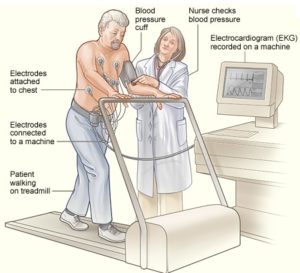![]() TREADMILL TEST (EXERCISE STRESS TEST)
TREADMILL TEST (EXERCISE STRESS TEST) 
The treadmill test is basically a continuous EKG monitoring during physical exertion with close attention to the blood pressure and heart rate. Its’ major use is to detect significant coronary artery disease (blockages in the coronary arteries). Frequently is used as part of the evaluation of patients with chest pain and arrhythmias (irregular heartbeats). It also provides assessment of the exercise capacity, circulation to the legs, and blood pressure and heart rate response to exercise. The test is performed according to standard protocols. The most commonly used is the Bruce protocol. It consists of three-minute stages at increasing speed and slope. This allows physicians anywhere in the world communicate and compare test results. One of the end-points of the exercise test is to achieve at least 85% of the age-predicted maximum heart rate. If a patient has a significant narrowing in the coronary arteries, the exercise may elicit chest discomfort (angina pectoris) or changes in the EKG. Although the regular treadmill test is extremely useful, it can occasionally miss coronary artery disease. Nuclear imaging done in conjunction with exercise testing will improve the overall accuracy of the test and provide useful information in regard to the location and severity of the blockages.


